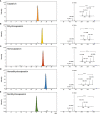Comprehensive phytochemical profiles and antioxidant activity of Korean local cultivars of red chili pepper (Capsicum annuum L.)
- PMID: 38318498
- PMCID: PMC10840139
- DOI: 10.3389/fpls.2024.1333035
Comprehensive phytochemical profiles and antioxidant activity of Korean local cultivars of red chili pepper (Capsicum annuum L.)
Abstract
Red chili pepper (Capsicum annuum L.), which belongs to the Solanaceae family, contains a variety of phytochemicals with health-promoting properties including capsaicinoids, phenolics and fatty acids. Red chili pepper is one of the most consumed vegetables in Korea and occupies the largest cultivated area among spices. In this study, the ethanolic extracts from two Korean local cultivars, namely Subicho and Eumseong, were analyzed using a hybrid trapped ion mobility Q-TOF mass spectrometer equipped with a UPLC system, and their phytochemical profiles were then compared with those of a common phytophthora disease-resistant cultivar called Dokbulwang, which is extensively used for red chili pepper powder in public spaces across Korea. Utilizing high-resolution ion-mobility Q-TOF MS analysis, 458 and 192 compounds were identified from the three different red chili peppers in positive and negative ion modes, respectively, by matching with a reference spectral library. Principal component analysis revealed clear distinctions among the three cultivars, allowing us to identify key phytochemical components responsible for discriminating the local cultivars from the public cultivar. Furthermore, the assessment of total flavonoid, phenolic, and antioxidant activity in the red pepper extracts, highlighted their diverse molecular and chemical profiles. Despite the higher total flavonoid and phenolic content values observed in the public cultivar, the radical scavenging rate was higher in the local cultivars, particularly in Subicho. This suggest the presence of stronger antioxidant compounds in the local cultivar, indicating their potential health benefits due to their rich content of bioactive compounds. Notably, the local cultivars exhibited significantly higher proportions of organic compounds (more than four times) and terpenoids (more than two times) compared to the public cultivar. Specifically, higher levels of five major capsaicinoid compounds were found in the local cultivars when compared to the public cultivar. The observed disparities in phytochemical composition and antioxidant activities indicate the molecular diversity present among these cultivars. Further exploration of the bioactive compounds in these local cultivars could prove invaluable for the development of native crops, potentially leading to the discovery of novel sources of bioactive molecules for various applications in health and agriculture.
Keywords: Capsicum annuum; Korean local cultivar; antioxidant activity; capsaicinoid; ion mobility Q-TOF; phytochemical; red chili pepper.
Copyright © 2024 Jang, Choi and Jang.
Conflict of interest statement
The authors declare that the research was conducted in the absence of any commercial or financial relationships that could be construed as a potential conflict of interest.
Figures






References
LinkOut - more resources
Full Text Sources

